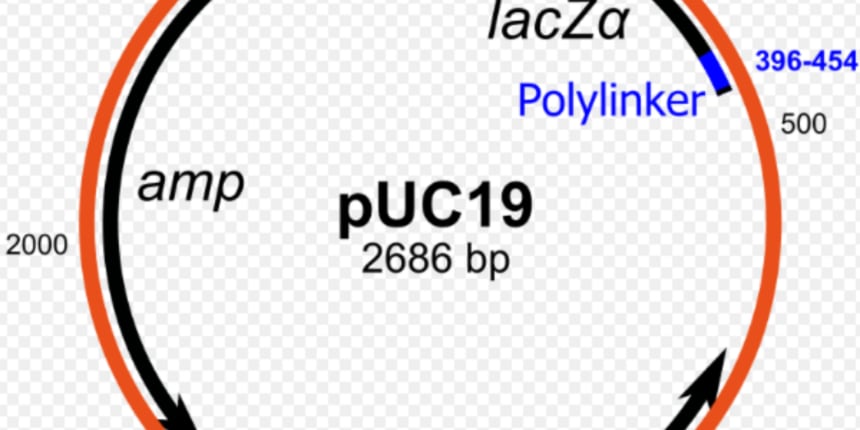pUC Vector Full Form
What is full form of pUC Vector?
pUC was created by Joachim Messing and co-workers. The pUC is a plasmid cloning vector. pUC is obtained through the process of modification of the pBR322 vector. pBR322 are greater than pUC as pUC is only 2.7 kb in size, but in comparison, pUC has a high copy number. Several 500 to 600 copies of plasmid per cell without amplification are being produced by the mutation within the origin of replication.
- What is full form of pUC Vector?
- Nomenclature of pUC Vector
- Construction of pUC Vector
- Advantages of pUC Vector
- Disadvantages of pUC Vector
- Similarities between pUC and pBR322
- Difference between pUC and pBR322
- Some Important Terms

Nomenclature of pUC Vector
P indicates the plasmid.
UC stands for the University of California where J. Messing first developed the pUC vector.
We may also see numbers after pUC like pUC8,pUC18,pUC19 and so on. They are a series of pUC and have been numbered for separation.
Construction of pUC Vector
Replication origin: It was derived from the replication origin of pBR322. Each transformed E. coli cell now contains between 500 and 600 copies of the plasmid due to the alteration of the pBR322 origin of replication by the use of a fortuitous mutation.
It has a gene for ampicillin resistance, a selectable marker. The non-transformed host cells may die, even when the transformed host cells have been growing in an ampicillin-containing media.
There are numerous cloning sites for the Lac Z gene (MCS). The beta-galactosidase enzyme reacts on the chromogenic (color-producing) substrate and substratum known as X-gal when Lac Z is introduced into the vector. An additional substance called isopropyl-thiogalactosidase, which is present in the same media, has been used to promote the expression of the Lac Z gene (IPTG).
Commonly Used Example: pUC19
It is a 2686 bp long plasmid.
Origin of replication – The origin of replication of the pUC19 plasmid is derived from pMB1.
Multiple Cloning Sites – There is a short sequence of 2.8 kb which contains sites for various restriction enzymes. This increases the number of potential restriction sites available, enabling the production of the desired fragment for cloning.
Selectable markers – The pUC19 plasmid contains an Ampicillin resistance gene which can be used to screen the recombinants. The plasmid also contains the E. coli gene lacZ, which encodes for β-galactosidase (β-galactosidase hydrolyses lactose).
Restriction sites – The pUC19 vector carries a 54 bp long multiple cloning site poly-linker containing 13 different hexanucleotide-specific restriction endonucleases sites.
Selection Test Used Using pUC19 Vector
For pUC19 vectors, the Blue-White screening method is used. The screening procedure is as follows:
This screening method is based on the fact that the blue pigment is formed when -galactosidase catalyses the hydrolysis of X-gal (5-bromo-4-chloro-3-indoyl—D-galactopyranoside) in the medium.
When X-gal is hydrolyzed, galactose and 5-bromo-4-chloro-3-hydroxy indole are formed.
The final product is dimerized and oxidised.
A blue colour colonies are produced as a result of dimerization and oxidation.
On agar medium containing X-gal, cells with -galactosidase activity form blue colonies, whereas cells without -galactosidase activity form white colonies.
Recombinant cells with newly inserted DNA fragments lack -galactosidase activity and thus appear white on agar plates.
This method of screening recombinant cells is the simplest and quickest.
Uses of pUC Vector
pUC vector has the following uses:
pUC vector is used as both a cloning vector and an expression vector.
Manipulation of DNA fragments
Advantages of pUC Vector
The following are the advantages of the pUC vector:
It possesses a high copy number of 500-600 copies per cell.
It has an easy and single-step selection
The unique restriction sites which are used for cloning get clustered in multiple cloning sites(MCS).
Disadvantages of pUC Vector
The following are the disadvantages of the pUC vector:
pUC vectors can not lodge a gene of interest greater than 15kb.
Immunogenicity and cytotoxicity
Similarities between pUC and pBR322
pUC and pBR322 are plasmid vectors.
pUC and pBR322 are cloning vectors for coli
pUC and pBR322 have multiple restriction sites.
pUC and pBR322 have an ampicillin resistance gene as a selectable marker.
Difference between pUC and pBR322
pUC | pBR322 |
Plasmid vector that is 2686 base pair in a length | Plasmid vector that is 461 base pair in a length |
High copy number plasmid | Low copy number plasmid |
Reporter gene-ꞵ galactosidase (Lac Z) gene | Reporter gene is not present. |
Some Important Terms
Cloning vector: It is a small piece of DNA that could be stably maintained in an organism.
Expression vector: It is a vector that has been designed to allow transcription and translation of an inserted section of DNA.
Frequently Asked Questions (FAQs)
pUC is considered a cloning vector as it conveys amp resistance.
E.coli is the host of plasmid pUC.
pUc plasmids are identified via an important feature. The important feature is a blue or white colony screen.
The pUC plasmid encodes ꞵ-lactamase through its bla gene.
No, pUC is an artificial plasmid.